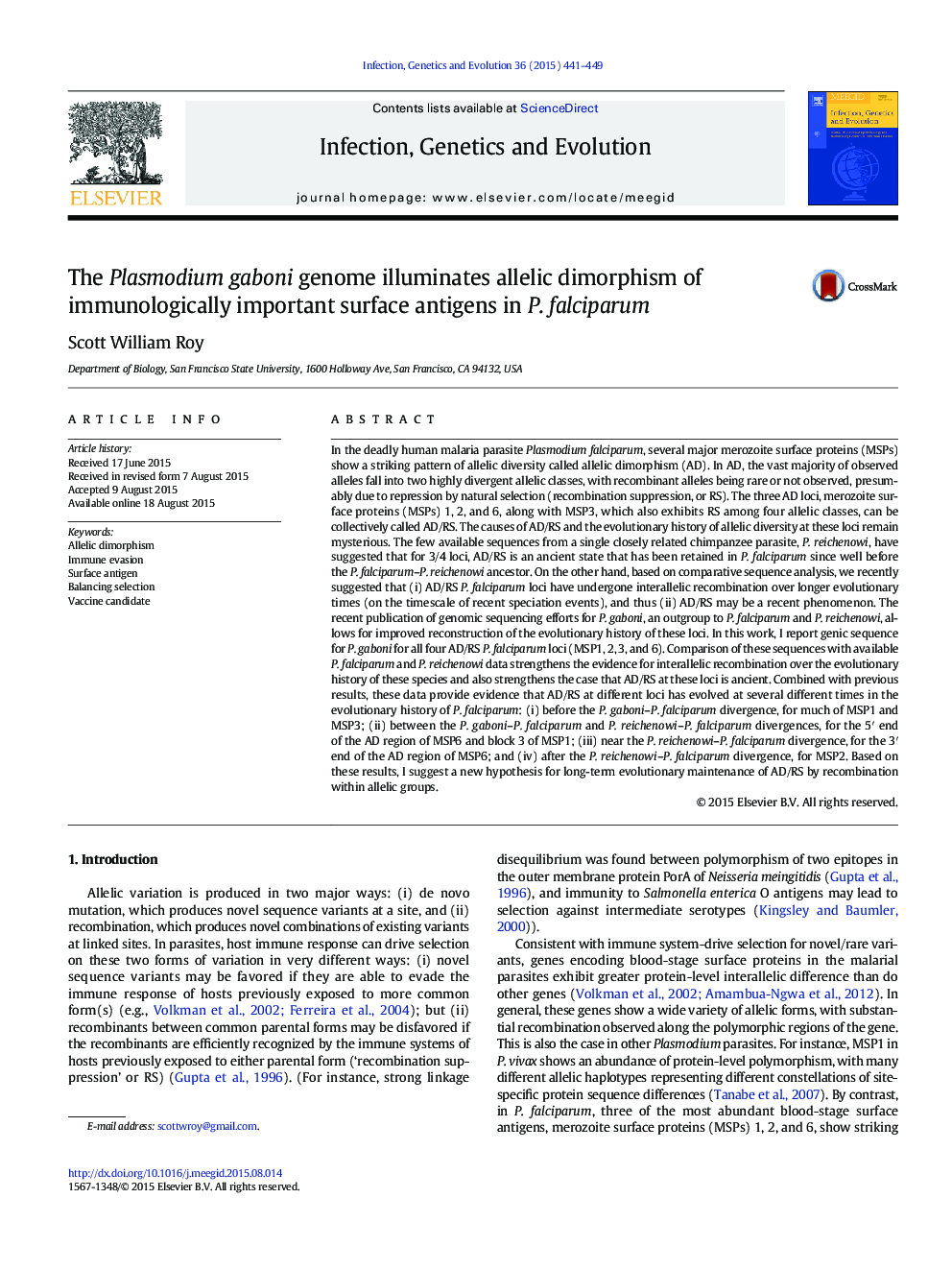| کد مقاله | کد نشریه | سال انتشار | مقاله انگلیسی | نسخه تمام متن |
|---|---|---|---|---|
| 5908634 | 1570167 | 2015 | 9 صفحه PDF | دانلود رایگان |
عنوان انگلیسی مقاله ISI
The Plasmodium gaboni genome illuminates allelic dimorphism of immunologically important surface antigens in P. falciparum
دانلود مقاله + سفارش ترجمه
دانلود مقاله ISI انگلیسی
رایگان برای ایرانیان
کلمات کلیدی
موضوعات مرتبط
علوم زیستی و بیوفناوری
علوم کشاورزی و بیولوژیک
بوم شناسی، تکامل، رفتار و سامانه شناسی
پیش نمایش صفحه اول مقاله

چکیده انگلیسی
In the deadly human malaria parasite Plasmodium falciparum, several major merozoite surface proteins (MSPs) show a striking pattern of allelic diversity called allelic dimorphism (AD). In AD, the vast majority of observed alleles fall into two highly divergent allelic classes, with recombinant alleles being rare or not observed, presumably due to repression by natural selection (recombination suppression, or RS). The three AD loci, merozoite surface proteins (MSPs) 1, 2, and 6, along with MSP3, which also exhibits RS among four allelic classes, can be collectively called AD/RS. The causes of AD/RS and the evolutionary history of allelic diversity at these loci remain mysterious. The few available sequences from a single closely related chimpanzee parasite, P. reichenowi, have suggested that for 3/4 loci, AD/RS is an ancient state that has been retained in P. falciparum since well before the P. falciparum-P. reichenowi ancestor. On the other hand, based on comparative sequence analysis, we recently suggested that (i) AD/RS P. falciparum loci have undergone interallelic recombination over longer evolutionary times (on the timescale of recent speciation events), and thus (ii) AD/RS may be a recent phenomenon. The recent publication of genomic sequencing efforts for P. gaboni, an outgroup to P. falciparum and P. reichenowi, allows for improved reconstruction of the evolutionary history of these loci. In this work, I report genic sequence for P. gaboni for all four AD/RS P. falciparum loci (MSP1, 2, 3, and 6). Comparison of these sequences with available P. falciparum and P. reichenowi data strengthens the evidence for interallelic recombination over the evolutionary history of these species and also strengthens the case that AD/RS at these loci is ancient. Combined with previous results, these data provide evidence that AD/RS at different loci has evolved at several different times in the evolutionary history of P. falciparum: (i) before the P. gaboni-P. falciparum divergence, for much of MSP1 and MSP3; (ii) between the P. gaboni-P. falciparum and P. reichenowi-P. falciparum divergences, for the 5â² end of the AD region of MSP6 and block 3 of MSP1; (iii) near the P. reichenowi-P. falciparum divergence, for the 3â² end of the AD region of MSP6; and (iv) after the P. reichenowi-P. falciparum divergence, for MSP2. Based on these results, I suggest a new hypothesis for long-term evolutionary maintenance of AD/RS by recombination within allelic groups.
ناشر
Database: Elsevier - ScienceDirect (ساینس دایرکت)
Journal: Infection, Genetics and Evolution - Volume 36, December 2015, Pages 441-449
Journal: Infection, Genetics and Evolution - Volume 36, December 2015, Pages 441-449
نویسندگان
Scott William Roy,